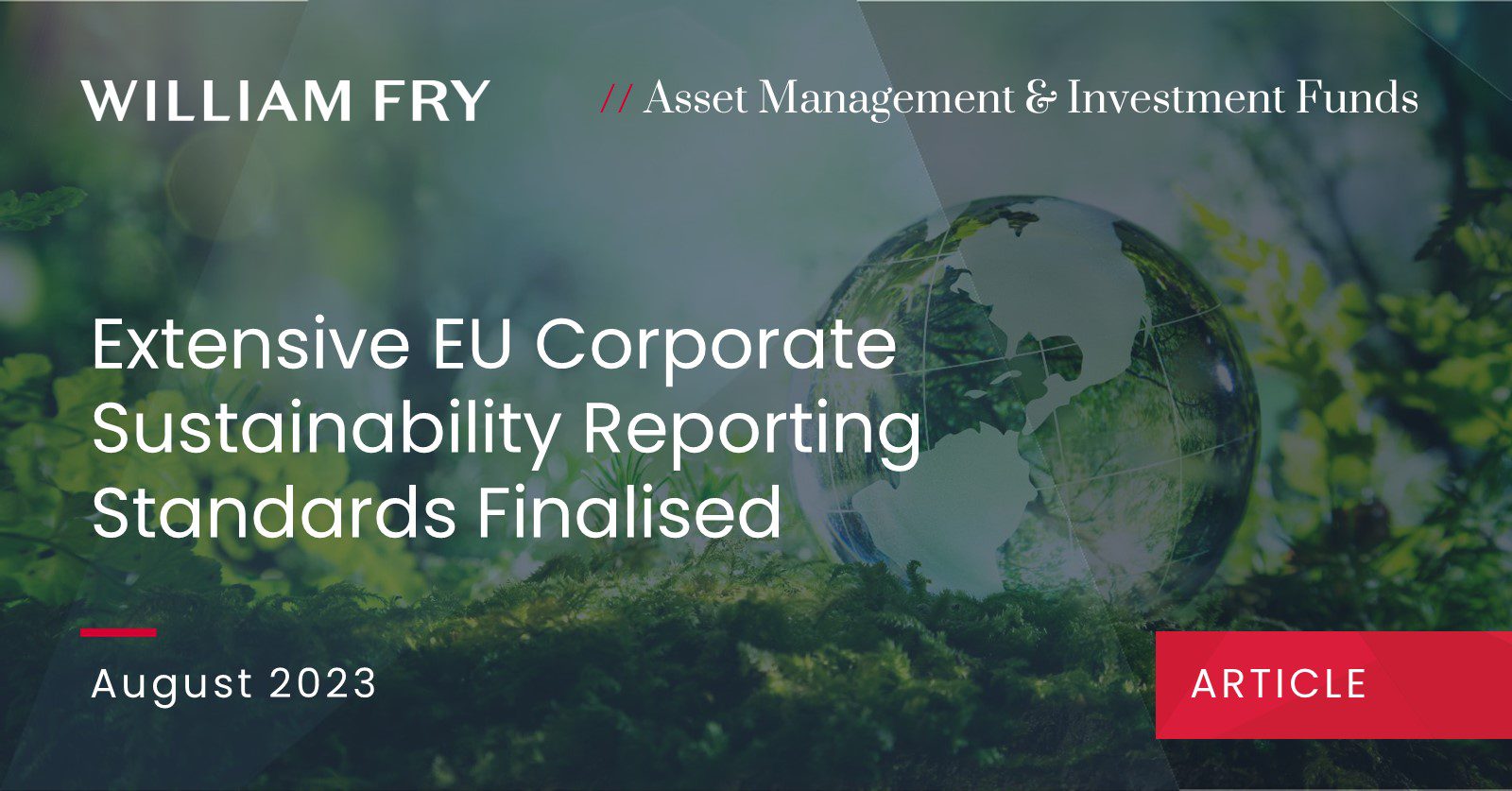The new EU sustainability reporting regime for companies, set out under the Corporate Sustainability Reporting Directive (CSRD), will first apply from 1 January 2024 to large EU listed companies and parents of large groups, with more than 500 employees i.e., those companies already subject to CSRD’s predecessor, the Non-Financial Reporting Directive (NFRD).
On a phased-basis, CSRD will apply to all large EU companies and EU parents of large groups (for financial years 2025), EU listed SMEs (for financial years 2026, subject to two year opt-out), and non-EU companies with significant operations in the EU (for financial years 2028). For further details, see our previous briefing on scoping CSRD obligations.
Latest development
On 31 July 2023, the first set of mandatory, sector-agnostic, EU sustainability reporting standards (the ESRS), detailing the required content and presentation of CSRD sustainability reports, were adopted by the Commission. The ESRS will now be subject to a period of scrutiny before entering into effect in advance of the first CSRD application date of 1 January 2024. Additional ESRS, including sector-specific, SME proportionate and third country-equivalent ESRS are scheduled for publication by 30 June 2024.
The ESRS, which provide for double-materiality reporting (i.e., reporting on both a company’s impact on the environment and society as well as on the risks and opportunities for the company created by environmental and societal factors) include two cross-cutting, one governance, five environmental, and four social standards.
The ten environmental, social and governance (ESG) ESRS apply subject to a materiality assessment which must be undertaken to determine whether information should be reported on the basis that is relevant to the individual company or can be omitted if assessed as not relevant (the materiality threshold).
A summary of the disclosure requirements under each of the first 12 ESRS is set out below, along with key points for consideration when implementing the ESRS.
Key points for ESRS implementation
1. ESRS & the materiality assessment
The materiality threshold, under the ESRS adopted on 31 July last, applies more broadly than was proposed in the draft ESRS submitted by EFRAG (EU body charged with drafting the ESRS). This broader application, which the Commission hopes will significantly reduce the CSRD reporting burden for in-scope companies, means that all individual disclosures and datapoints required under the ESG ESRS are only reportable by a particular in-scope company if assessed as relevant to that company’s business model and activities. A matter is to be considered material if it has a material impact and/or is financially material to the particular in-scope company. Impact materiality being assessed by reference to actual or potential, positive or negative material impacts (including those of its own operations, upstream and downstream value chains, its products and services and its business relationships) on the environment of society over the short, medium, or long-term. A matter will be financially material if it could trigger material financial effects on the company. Further guidance from EFRAG has been promised on the materiality assessment process.
While companies may omit non-material information when reporting under the ESG ESRS, the Commission notes that the materiality threshold does not render those standards voluntary. Companies must adopt robust, third-party assured, materiality due diligence processes in accordance with the ESRS; which, in the case of impacts, must be based on factors such as the scale, scope and severity of the impact and, in the case of financial materiality, based on factors such as the level of influence the matter may have on the company’s financial development. Detailed explanations of any non-material conclusions for ESRS1 must, where applicable, be reported by in-scope companies, alongside reporting on any material information.
2. Interoperability with other EU sustainability reporting rules and global standards
While the inclusion of the ESG ESRS materiality threshold is undoubtedly a welcome development for those subject to CSRD, there are many in the financial services sector which require data reported under the ESRS to comply with their own mandatory sustainability reporting under other EU sustainable finance rules e.g., the Sustainable Finance Disclosures Regulation (SFDR), the Benchmark Regulation (BMR), or the Capital Requirements Regulation (CRR).
For those subject to SFDR, BMR or CRR, the Commission notes that the ESRS provide for disclosure of a table detailing where in the CSRD report any datapoint derived from those regimes can be found or explicitly stating that it is considered non-material by the investee company. In addition, the Commission intends to provide ‘further clarifications’ for reporting, under SFDR, BMR and CRR, on exposures to/investments in companies which report required data as non-material under the ESRS. The Commission also notes that, for SFDR principal adverse impact reporting, any indicator reported as non-material by an investee company under the ESRS may be assumed not to contribute to the corresponding SFDR PAI indicator.
In respect of global sustainability reporting standards, the Commission confirms that the ESRS have a ‘very high level of alignment’ with the standards of the International Sustainability Standards Board (ISSB) and the Global Reporting Initiative (GRI). As a result, companies will report, ‘to a very large extent’, the same information when reporting under the ESRS on climate change as when using the ISSB standard for climate-related disclosures. The intention being that companies subject to the ESRS, that also wish to comply with the ISSB standards, would not have to separately report under the ISSB standards. However, when compared to the ISSB standards, the ESRS require additional information including on non-climate environmental (as well as social and governance) impacts from a double-materiality perspective.
3. CSRD exemptions and phase-ins
The following permanent/temporary exemptions are provided for under CSRD and/or the ESRS:
- EU listed SMEs may comply or explain non-compliance with CSRD until 1 January 2028.
- Large/EU listed subsidiaries* are exempt from CSRD sustainability reporting if included in a CSRD/third-country equivalent consolidated sustainability report.
- Large/EU listed subsidiaries*+ of non-EU parents are exempt until 6 January 2030 if included in an ‘artificial’ consolidated sustainability report (covering all large or EU listed EU subsidiaries).
- Where in-scope non-EU parents fail to make the necessary information available to its EU subsidiaries/branches to comply with the requirement to publish CSRD sustainability reports at group level/individual level of the non-EU entity (if not part of group), the subsidiaries/branches may publish, alongside their CSRD sustainability report, a statement confirming the information was not made available by the non-EU parent/entity.
- In-scope companies with <750 employees may omit scope 3 emissions in year one reports and biodiversity, value-chain workers, affected communities and end-users in years one and two reports.
- All in-scope companies:
- are subject to limited assurance (initially under national rules and then, once adopted, CSRD limited assurance standards) until CSRD reasonable assurance standards adopted (scheduled for finalisation by 1 October 2028);
- can omit financial effects of non-climate environmental issues and certain own workforce data in year one reports;
- are subject to voluntary reporting of certain datapoints including biodiversity transition plans, certain indicators about ‘non-employees’ in their workforce, and explanations of why particular sustainability topics are assessed as non-material;
- may avail of certain flexibilities for some mandatory datapoints e.g., on the financial effects of sustainability risks, engagement with stakeholders and the materiality assessment process;
- may omit data on value chains in years one, two and three reports.
- UCITS and AIFs are specifically exempt from CSRD.
*no exemption for companies which are both large and EU listed
+ subsidiary must be one that generated the greatest turnover in the EU in at least one of preceding 5 f/y
4. CSRD sustainability reports must be:
- included in the management/directors’ report and must be digitally tagged;
- published within 12 months of the balance sheet date (it is expected that national transposition measures will permit satisfaction of the publication requirement by filing with the Companies Registration Office);
- subject to exemptions, prepared on a consolidated basis for EU parents of large groups;
- subject to exemptions, prepared at group-level for in-scope non-EU parents;
- consider the company’s own operations, its value chain, including its products and services, business relationships and supply chain; and
- subject to limited assurance, moving to reasonable assurance once relevant ESRS are adopted (currently scheduled to be finalised by 1 October 2028).
Summary of disclosure requirements under first set of ESRS
1. Cross-Cutting Standards:
- ESRS 1 General requirements
This standard includes general principles for reporting under the ESRS including on double materiality; due diligence; value chain; time horizons; presentation; and transitional provisions.
- ESRS 2 General disclosures
This standard includes mandatory disclosure requirements (not subject to materiality threshold) for all in-scope companies on the governance of sustainability matters; sustainability strategy; process to take account of interests and views of stakeholders; material sustainability impacts, risks and opportunities and their interaction with strategy and business model; materiality assessment process and the information omitted as not material; policies adopted to manage material sustainability risks; resources and actions in relation to material sustainability matters and metrics used to track the effectiveness of such actions.
2. ESG Standards (subject to materiality threshold):
- ESRS E1 Climate change
This standard requires disclosures including on the integration of sustainability-related performance in incentive schemes; transition plans for climate change; metrics and targets related to climate change adaptation and mitigation; energy consumption and mix; Scopes 1, 2, and 3 emissions; emissions removals and mitigation projects; internal carbon pricing and anticipated effect of material physical and transition risks and potential climate-related opportunities.
- ESRS E2 Pollution
This standard requires disclosures including of the processes to identify and assess material pollution-related impacts, risks and opportunities; policies, targets, actions and resources related to pollution; anticipated financial effects from pollution-related impacts, risks and opportunities.
- ESRS E3 Water and marine resources
This standard requires disclosures including of the processes to identify and assess material water and marine resources-related impacts, risks and opportunities; policies, actions, targets and resources related to water and marine resources, water consumption and anticipated financial effects from water and marine resources-related impacts, risks and opportunities.
- ESRS E4 Biodiversity and ecosystems
This standard requires disclosures including of transition plans and consideration of biodiversity and ecosystems in strategy and business model; processes to identify and assess material biodiversity and ecosystem-related impacts, risks and opportunities; policies, actions, targets, impact metrics and resources related to biodiversity and ecosystems; anticipated financial effects from biodiversity and ecosystem-related risks and opportunities.
- ESRS E5 Resource use and circular economy
This standard requires disclosures including of the processes to identify and assess material resource use and circular economy-related impacts, risks and opportunities; policies, actions, targets and resources (inflows and outflows) related to resource use and circular economy; and anticipated financial effects from resource use and circular economy-related impacts, risks and opportunities.
- ESRS S1 Own workforce
This standard requires disclosures including of the policies related to own workforce; processes for engaging with own workers and workers’ representatives about impacts; processes to remediate negative impacts and channels for own workers to raise concerns; taking action on material impacts on own workforce, and approaches to mitigating material risks and pursuing material opportunities related to own workforce, and effectiveness of those actions; targets related to managing material negative impacts, advancing positive impacts, and managing material risks and opportunities; characteristics of the undertaking’s employees; characteristics of non-employee workers in the undertaking’s own workforce; collective bargaining coverage and social dialogue; diversity metrics; adequate wages; social protection; persons with disabilities; training and skills development metrics; health and safety metrics; work-life balance metrics; compensation metrics (pay gap and total compensation); incidents, complaints and severe human rights impacts.
- ESRS S2 Workers in the value chain
This standard requires disclosures including of the policies related to value chain workers; processes for engaging with value chain workers about impacts; processes to remediate negative impacts and channels for value chain workers to raise concerns; taking action on material impacts on value chain workers, and approaches to managing material risks and pursuing material opportunities related to value chain workers, and effectiveness of those action; targets related to managing material negative impacts, advancing positive impacts, and managing material risks and opportunities.
- ESRS S3 Affected communities
This standard requires disclosures including of the policies related to affected communities; processes for engaging with affected communities about impacts; processes to remediate negative impacts and channels for affected communities to raise concerns; taking action on material impacts on affected communities, and approaches to managing material risks and pursuing material opportunities related to affected communities, and effectiveness of those actions; targets related to managing material negative impacts, advancing positive impacts, and managing material risks and opportunities.
- ESRS S4 Consumers and end-users
This standard requires disclosures including of the policies related to consumers and end-users; processes for engaging with consumers and end-users about impacts; processes to remediate negative impacts and channels for consumers and end-users to raise concerns; taking action on material impacts on consumers and end-users, and approaches to managing material risks and pursuing material opportunities related to consumers and end-users, and effectiveness of those actions; targets related to managing material negative impacts, advancing positive impacts, and managing material risks and opportunities.
- ESRS G1 Business conduct
This standard requires disclosures including of the role of the administrative, supervisory and management bodies; description of the processes to identify and assess material impacts, risks and opportunities; corporate culture and business conduct policies and corporate culture; management of relationships with suppliers; prevention and detection of corruption and bribery; confirmed incidents of corruption or bribery; political influence and lobbying activities; payment practices.
Contact Us
If you have any queries on the issues discussed in this article, please get in touch with the key contacts, any member of the ESG & Sustainability practice group, the Asset Management & Investment Funds team, or your usual William Fry contact.



